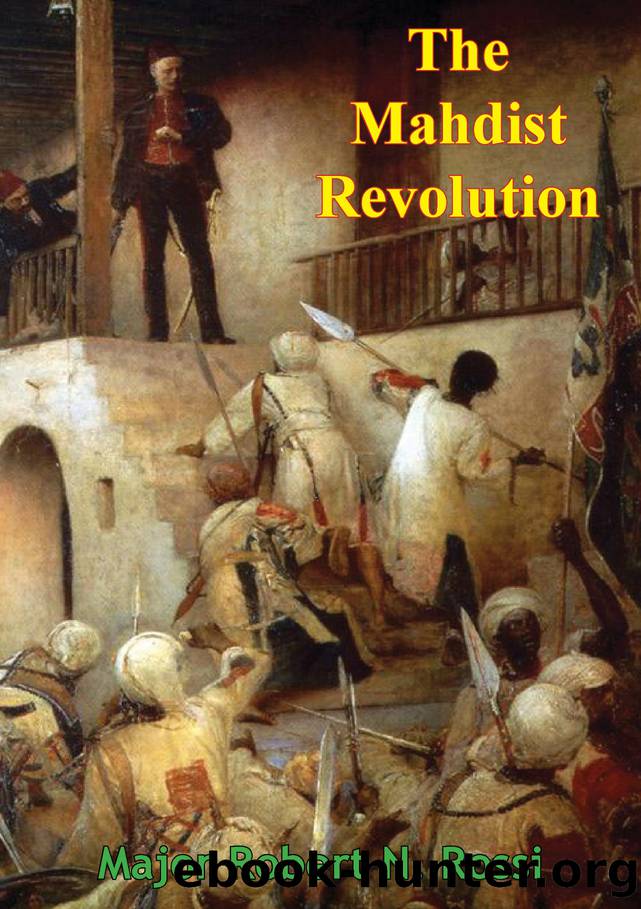The Mahdist Revolution by Rossi Major Robert N.;

Author:Rossi, Major Robert N.;
Language: eng
Format: epub
Publisher: Normanby Press
Published: 2015-10-13T00:00:00+00:00
CHAPTER 9 â KHARTOUM
Under British pressure, and nearly bereft of manpower the Khedive of Egypt had agreed to evacuate the Sudan after the defeat of the Hicks and Baker relief expeditions. The British agreed to help carry out the evacuation. London suggested General Charles Gordon of England. Gordon quickly left England and arrived in Cairo on 26 January 1884. He spent only two days in the Egyptian capitol before leaving for the Sudan, meeting with the British ministers and the Khedive before his departure. His destination was Khartoum, some 2,000 miles up the Nile. His mission was limited: evacuate the remaining Egyptian garrisons in the Sudan and turn over the government of the Sudan to the local Sudanese.
Gordon wanted to turn the Sudan over to Zebehr Pasha, the Khediveâs original choice for Gordonâs job. Zebehr was a native Sudanese who had conquered Darfur province and added it to Egyptian colonial rule as part of the Sudan. He was in Egypt under detention as a result of slave trading and political activities in the Sudan prior to the appearance of the Mahdi. However, the British government had blocked Zebehrâs appointment, fearing public opinion would turn against them if they backed the nomination of a famous slave trader.{35} Because the Khedive, at British insistence, had retained Zebehr in Egypt, Gordon was faced with conducting the evacuation while searching for a suitable candidate to assume the reins of government.
Gordon arrived in Khartoum on 18 February 1884, after a 21 day journey from Cairo. The senior officer in Khartoum upon Gordonâs arrival was Colonel Coetlogan. He had come to Khartoum with Hicks and had replaced Hicks as commandant of Khartoum. Colonel Coetlogan had already begun to prepare Khartoum for a siege. With the destruction of the Hicksâ column the previous November, Khartoumâs vulnerability to the Mahdi had become obvious. The Sennar province area immediately to the south of Khartoum was already in revolt and by now largely controlled by Mahdist forces, although the Mahdi himself had not yet moved out of Kordofan province against Khartoum.
By this time the Mahdi had expanded his activities beyond the command of a revolutionary army. He had also formed a revolutionary government. The Mahdi set up his government in accordance with Islamic tradition. He ran a treasury, a judicial system, and held audiences for his followers. He was also consolidating support for his cause and organizing his efforts for what lay ahead. Although he controlled a large military force and a good deal of territory with its attendant population, he was still personally isolated in Kordofan province from major events. Although his base of operations in Kordofan was now secure from Egyptian reprisals, he had no way of knowing that from now on he clearly held the initiative. His victory over Hicks and the spread of the revolt to other parts of the Sudan had convinced the British to pressure the Khedive to cut his losses and withdraw from the Sudan. The Mahdi did not yet know this, but
Download
This site does not store any files on its server. We only index and link to content provided by other sites. Please contact the content providers to delete copyright contents if any and email us, we'll remove relevant links or contents immediately.
The Vikings: Conquering England, France, and Ireland by Wernick Robert(79222)
Ali Pasha, Lion of Ioannina by Eugenia Russell & Eugenia Russell(39939)
The Vikings: Discoverers of a New World by Wernick Robert(36831)
The Conquerors (The Winning of America Series Book 3) by Eckert Allan W(36715)
Cecilia; Or, Memoirs of an Heiress — Volume 1 by Fanny Burney(32093)
Cecilia; Or, Memoirs of an Heiress — Volume 3 by Fanny Burney(31481)
Cecilia; Or, Memoirs of an Heiress — Volume 2 by Fanny Burney(31435)
Empire of the Sikhs by Patwant Singh(22779)
Hans Sturm: A Soldier's Odyssey on the Eastern Front by Gordon Williamson(18341)
The Secret History by Donna Tartt(18267)
Cat's cradle by Kurt Vonnegut(14804)
Sapiens: A Brief History of Humankind by Yuval Noah Harari(14006)
Pimp by Iceberg Slim(13828)
Talking to Strangers by Malcolm Gladwell(12916)
Norse Mythology by Gaiman Neil(12879)
Leonardo da Vinci by Walter Isaacson(12833)
Underground: A Human History of the Worlds Beneath Our Feet by Will Hunt(11857)
4 3 2 1: A Novel by Paul Auster(11843)
The Radium Girls by Kate Moore(11651)
